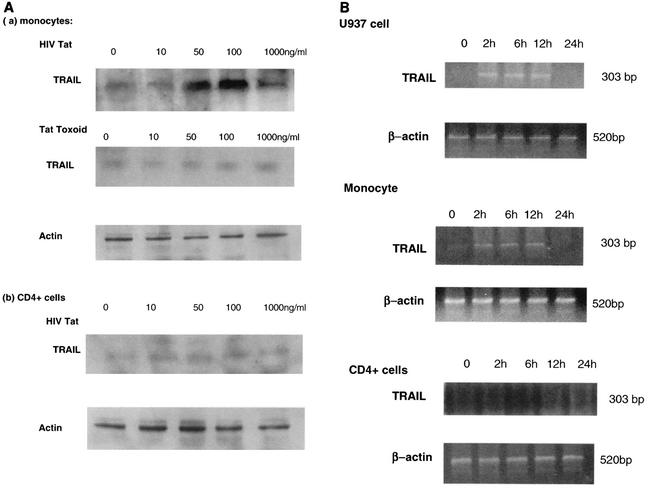FIG. 2.
HIV Tat increases TRAIL expression in U937 cells and human monocytes, but Tat toxoid does not. (A) TRAIL expression increases with increasing doses of Tat protein. Monocytes (a) and CD4+ cells (b) were incubated with or without HIV Tat or Tat toxoid (10 to 1,000 ng/ml) at 37°C for 20 h, and 10 μl of cell lysate (6 × 104 cell equivalents) was separated by SDS-10% PAGE. Cell proteins were transferred to nitrocellulose membranes and immunoblotted with polyclonal anti-TRAIL (H-257; 1:1,000). Lanes (from left): 1, no HIV Tat protein; 2 to 5, cell extracts exposed to 10, 50, 100, and 1,000 ng of Tat/ml, respectively. Actin (antibody A-2668; Sigma) was an internal control. Similar results were obtained with fresh human monocytes and with the U937 cell line. TRAIL production in fresh human T cells or in Jurkat cells was not stimulated by exposure to Tat. (B) HIV Tat induces the transcription of TRAIL mRNA in U937 cells and monocytes. Total RNA from U937 cells, monocytes, or CD4+ cells was isolated and subjected to reverse transcription-PCR. β-Actin mRNA was amplified over 25 cycles and TRAIL mRNA was amplified over 35 cycles of PCR. Transcription of control β-actin or TRAIL/APO2L mRNA in U937 cells is shown after 0, 2, 6, 12, or 24 h of incubation in the presence of HIV Tat (100 ng/ml).

